Looking Back at the 10 Biggest Shale-Related Storylines of 2017
What a difference a year can make.Although that saying is about as cliché as it gets, it perfectly sums up a strong 2017 for the U.S. oil and natural gas industry on numerous fronts. Following some rough sledding from late 2014 through 2016, the shale industry not only enjoyed a resurgence this past year — it is clearly in the early stages of a new revolution that has been described as Shale 2.0. Here’s a look back at the top-10 shale-related storylines of 2017.
1. U.S. Cements Status as World’s Top Oil & Gas Producer, Poised for Record Production
Not only did the U.S. retain its status as the world’s largest oil and natural gas producer for the fifth straight year this past year (see chart below), it became clear in 2017 that this is a title we won’t soon relinquish.
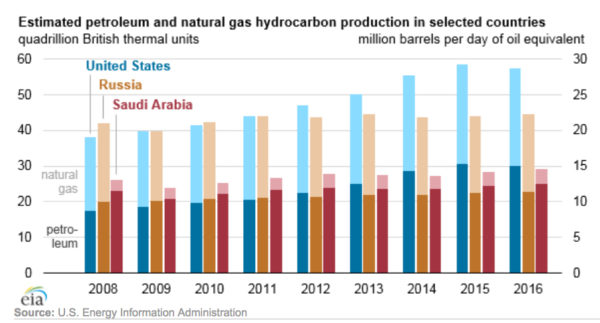
Emboldened by OPEC’s unconditional surrender following its failed failed price war — and bolstered by the improved technology and efficiency that war necessitated — U.S. shale producers pushed domestic oil production up by more than 650,000 barrels per day (b/d) between January and September of this year.
Weekly production actually reached record levels seven weeks in a row in the final two months of the year, as the following Energy Information Administration (EIA) chart illustrates.
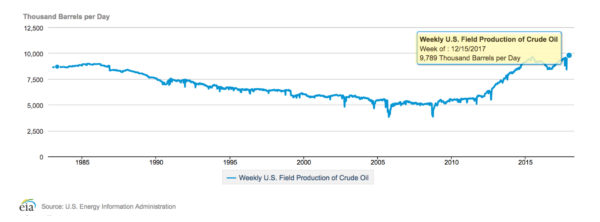
The EIA now forecasts U.S. oil output will surpass 10 million b/d in 2018, shattering the all-time record set in the early 1970s, thanks to a nearly 1.2 million b/d increase in oil production from shale development alone in 2017.
This incredible production growth can be traced to higher (and more stable) commodity prices in the wake of OPEC’s surrender, and the fact that the average shale oil breakeven price has dropped an incredible 42 percent since 2013, according to a recent World Bank report.

A similar success story has developed on the shale gas front. Between January and December of this year, U.S. shale gas output grew from about 47.6 billion cubic feet per day (Bcf/d) to more than 62.2 Bcf/d — a near 31 percent increase. Natural gas output from shale is projected to grow even further in 2018, with the EIA estimating an increase of 764 million cubic feet per day (MMcf/d) from December 2017 to January 2018, as production gains continue to be driven by the surging Appalachian Basin.
Energy expert Dr. Agnia Grigas might have summed it up best earlier this year when she said that we are in the midst of the “golden age” of American natural gas.
And incredibly, the International Energy Agency (IEA) recently released a report that forecasts U.S. oil and natural gas production increasing 50 percent higher than any country has ever achieved over the next decade, cementing America’s status as the “undisputed leader” in global oil and natural gas production.
2. Record Oil and LNG Exports
Even more stunning than the U.S.’s march toward shattering all-time record for oil and natural gas production was the fact that we achieved record oil and natural gas exports in 2017.
According to the EIA, U.S. liquefied natural gas (LNG) exports averaged 1.9 Bcf/d through November of this year, something almost unthinkable a decade ago when the U.S. was importing more than 3 Bcf of LNG per day. Moreover, U.S. LNG export capacity increased from about 1.5 Bcf/d in January to roughly 2.8 Bcf/d by the end of the year. U.S. LNG export capacity expected to nearly quadruple by 2019 as additional terminals come on line, as the following EIA graphic illustrates.
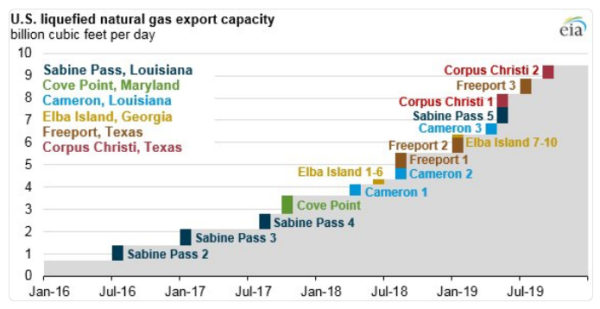 Spurred by this LNG export growth, the U.S. not only became a net exporter of natural gas for the first time in nearly 60 years in 2017, it is on a clear path to becoming the world’s leading LNG exporter in the not-so-distant future.
Spurred by this LNG export growth, the U.S. not only became a net exporter of natural gas for the first time in nearly 60 years in 2017, it is on a clear path to becoming the world’s leading LNG exporter in the not-so-distant future.Similar to LNG exports, U.S. crude exports have gone from essentially being non-existent to approaching a record 2 million barrels per day (mbpd) in 2017.
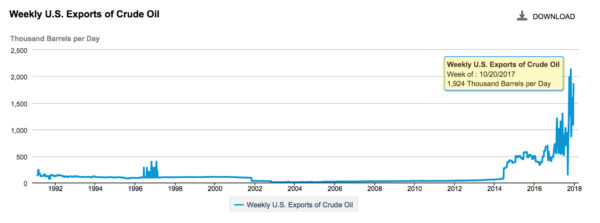 As
impressive as these figures are, an even more important storyline is
the fact that booming U.S. oil and natural gas exports have not have not caused domestic energy prices to spike, as many naysayers claimed would happen.
As
impressive as these figures are, an even more important storyline is
the fact that booming U.S. oil and natural gas exports have not have not caused domestic energy prices to spike, as many naysayers claimed would happen.Americans are actually enjoying record low energy prices, as residential, industrial and commercial natural gas costs have fallen since 2010. Residential natural gas prices have dropped dramatically in places like Pennsylvania (40 percent decline) and West Virginia ($4.3 billion decline) since shale development began.
3. U.S. Emissions Continue to Decline Even as Production Skyrockets
Data released in 2017 confirm beyond a shadow of a doubt that the U.S. is not only the world’s top oil and gas producer, we are also leading the world in greenhouse gas reductions.
The latest EIA data show that energy-related CO2 emissions fell 1.7 percent in 2017 and are at their lowest levels in a quarter of a century. The U.S. has reduced energy-related carbon emissions 14 percent since 2005 — a trend that can be largely credited to increased natural gas use for electricity generation, and you don’t have to take our word for it.
EIA published data this year showing that 63 percent of the 3,176 million metric ton (MMT) drop in CO2 emissions from 2005 to 2016 can be directly attributed to switching to natural gas for electricity generation. Overall, shifting to natural gas for power production has resulted in a 2,007 MMT reduction in CO2 emissions since 2005, almost twice the amount that can be attributed to renewable energy sources.
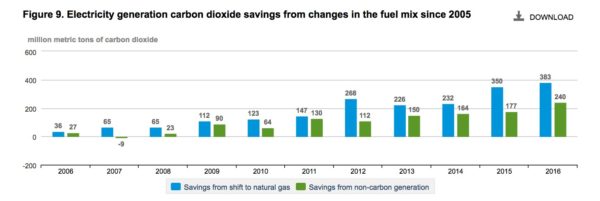
It is with these facts in mind that United Nations Energy Programme chief Erik Solheim recently said, “In all likelihood, the United States of America will live up to its Paris commitment, not because of the White House, but because of the private sector.”
But what about the methane leaks that anti-fracking activists claim wipe out natural gas’ climate benefits? The latest U.S. Environmental Protection Agency (EPA) data also refutes the “Keep It In the Ground” movement’s favorite go-to claim that oil and gas production are driving up methane emissions and exacerbating climate change.
A recent EID report based on EPA Greenhouse Gas Reporting Program (GHGRP) data finds that methane emissions from major onshore oil and natural gas production facilities declined by nearly 14 million metric tons between 2011 and 2016, and have declined in virtually every major oil and natural gas basin during that timespan.
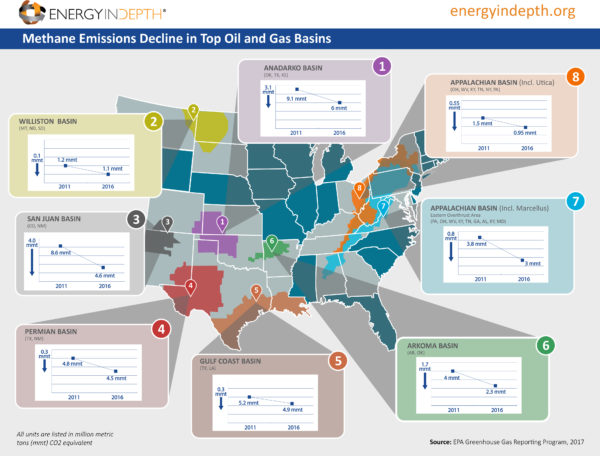
EPA data released this year also show that oil and natural gas system methane emissions have declined 19 percent since 1990 at the same time natural gas production has increased 51 percent and oil production has increased 28 percent.

The IEA’s latest World Energy Outlook (WEO) also confirms that the U.S. oil and gas industry is outpacing the rest of the world when it comes to methane mitigation, with leakage rates 30 percent below the global average of 1.7 percent. The WEO also confirms that natural gas has considerable climate benefits when compared to other traditional fuels, “even taking methane leakage into account.”
The latest EPA data also show emissions of criteria pollutants responsible for killing millions worldwide continued to plummet in 2017 thanks to increased natural gas use made possible by fracking.

4. Pipeline Progress (Finally!)
Critical midstream development lagged behind surging upstream development for much of 2017, due largely to the Federal Energy Regulatory Commission’s (FERC) lack of a quorum for more than a half year. But fortunately, FERC finally reached quorum in August and has begun to address a $50 billion backlog of needed pipeline construction projects.
Since August, FERC has approved dozens of natural gas pipeline projects totaling 8 Bcf/d of transportation capacity, including the Atlantic Coast (1.7 Bcf/d) and Mountain Valley (2 Bcf/d) pipeline projects. Earlier in the year, FERC managed to approve the Atlantic Sunrise (1.7 Bcf/d) and Rover (3.25 Bcf/d) pipelines. Both are currently under construction, as are the Leach Express (1.5 Bcf/d), Nexus (1.5 Bcf/d) and Mariner East 2 pipelines.
On the oil side, the Dakota Access Pipeline (DAPL) is finally in operation following a well-publicized “Keep It In the Ground”-generated saga, and the DAPL is already spearheading Bakken resurgence. The Keystone XL has also finally cleared its final regulatory hurdle nine years after sparking the anti-pipeline madness that the “Keep It In the Ground” movement continues to cling to, knowing full and well that impeding pipeline construction is its only potential path to achieving its stated goal of curtailing U.S. oil and gas development.
That said, despite some welcome pipeline progress in 2017, the latter KIITG focus will no doubt remain an obstacle moving forward. As acting FERC Chairman Neil Chatterjee recently said,
“[W]e see well funded, sophisticated national environmental organizations that understand how to use all the levers of state and federal government to frustrate pipeline development.”Speaking of state government, New York officials continues to block several key projects (Constitution, Valley Lateral, Millenium, Northern Access) despite having a state energy plan that calls for the use of more natural gas.
Nonetheless, the midstream bottleneck that impeded the shale revolution from reaching its full potential — particularly in the Appalachian Basin, where $23 billion has been invested in various projects — is finally widening a bit.
5. U.S. Upstream Investment Skyrockets
A recent report finds the U.S. is the most attractive region for upstream oil and gas investment. That could explain why the IEA’s 2017 World Energy Investment report finds that U.S. shale investment grew 53 percent in 2017, far outpacing upstream oil and gas investment in other countries.

Major investments announced this year include ExxonMobil’s acquisition of roughly 275,000 acres in the Permian Basin for $6.6 billion in January, as well as EQT’s $8.2 billion acquisition of Marcellus producer Rice Energy.
Overall, there was $19.8 billion in private equity funding raised for energy ventures in the first quarter of the year alone. This focus in investment shows no signs of slowing either, as oil producers are expected to spend $100 billion in U.S. oil fields next year.
6. Petrochemical Manufacturing Booming — Thanks to Shale
The American Chemistry Council (ACC) reported earlier this year that 310 chemical industry projects totaling $185 billion in new capital investment are currently in the works. These projects are expected to create 464,000 direct or indirect jobs by 2025, and all of this is happening for one reason — the shale gas revolution.
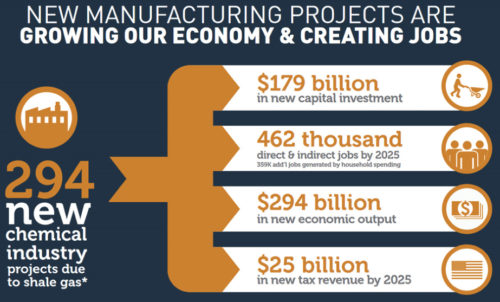
ACC’s announcement actually came before news broke in November that China Energy Investment Corp. plans to invest $83.7 billion in shale-related chemical manufacturing, power generation and underground natural gas liquid (NGLs) storage facilities in West Virginia.
That is just one of the exciting major announcements made in Appalachia this year, as a pair of ethane cracker facilities are in the works in Ohio and Pennsylvania, respectively, as is a possible major storage hub for NGLs used for plastics manufacturing.
The Gulf coast is also home to eight of the nine new ethylene cracker plant facilities recently built or under construction in the U.S., as well as three expansion projects and the only facility in America that is being re-started.
No wonder plastics manufacturing is suddenly booming, as it manufacturing in general. A recent report found U.S. manufacturing output is at a 13-year high.
None of this investment, whether in the Gulf Coast or Appalachia, would be possible without fracking unlocking the vast needed resources to rejuvenate American manufacturing. As Mark Denzler, Vice President & Chief Operating Officer of the Illinois Manufacturers’ Association, told EID in the fall,
“According to recent studies, nearly 90 percent of manufacturers are optimistic about the economy and data shows that factory orders are at a 13-year high. Innovative energy production, especially in shale with hydraulic fracturing, are helping lead this renaissance economy by creating low cost and efficient sources of energy. As the primary feedstock, it is also leading to a resurgence in the American chemical industry.”7. Shale Continues to Bolster America’s Global Standing
It wasn’t that long ago that the robust energy might of other nations — usually ones not particularly friendly to the U.S. — was used to manipulate America’s geopolitical influence and compromise our global standing. But thanks to fracking, that is no longer the case.
Whether it be the current turmoil in the Middle East or crisis in Venezuela, chaos in other parts of the world now has virtually no adverse affect on American energy prices and supply, and therefore isn’t forcing the U.S. to take a compromised position on the world stage.
As New York Times columnist Bret Stephens recently wrote,
“Fracking has meant we could sanction Iran’s oil exports and barely feel the consequences at the pump. … It turns out that we are in an era of energy superabundance, in which the United States is again the global leader.”
The United States’ renewed geopolitical might could very well be encapsulated by the recent five-year deal it struck to deliver LNG to Poland. Like much of the European Union — which has relied on Russia for 40 percent of its oil and 66 percent of its natural gas in recent years — Poland has long been under Vladimir Putin’s thumb. But America’s foray into the European energy market could ultimately erode Russia’s long-held status as a bully in the region.
As Jason Bordoff, director of the Center on Global Energy Policy at Columbia University and a former energy official in the Obama administration, recently said,
“The arrival of the U.S. gas is making Russia nervous. And they should be nervous.”That said, it really should come to no surprise that U.S. intelligence officials have confirmed long-held suspicions that Russia has pushed anti-fracking propaganda in an effort to undermine the industry (and also, possibly, funded U.S. green groups that oppose fracking). But oddly enough, despite being obsessed with Russia’s meddling in the U.S. election, the media has continued to largely ignore the Kremlin’s increasingly evident efforts to undermine America’s oil and natural gas industry.
“Forcing Russia to compete in a more competitive gas market in Europe and giving European consumers alternative sources of supply significantly weakens Russia’s geopolitical influence in Europe. The transition of the U.S. to one of the world’s largest gas exporters has very significant economic, environmental and geopolitical implications.”
8. Regulatory Rollback
Another major contributor to the oil and natural gas industry’s resurgence in 2017 was the refreshing new environment of regulatory sanity at the federal level.
The Trump administration announced on Thursday that it will repeal the Obama-era Bureau of Land Management (BLM) fracking rule in January, officially disposing of duplicative regulations that are already being enforced at the state level.
The BLM venting and flaring rule has also officially been suspended until 2019 and will likely never see the light of day in its current costly and duplicative form (even though environmentalists continue to fight the rule’s suspension in court).
The EPA also announced in June its intent to delay for two years the Obama administration’s New Source Performance Standards (NSPS) targeting methane in order to reconsider certain aspects of the rule. Though the courts have rejected the EPA’s delay and the rule is currently in effect, Congress has voted not to fund the rule, and its future remains bleak.
By rolling back these costly, duplicative and unnecessary regulations, the current administration has allowed the oil and natural gas industry to drive U.S. employment and GDP growth in 2017. Not coincidentally, the U.S. economy grew three percent in the third quarter. And oh by the way, oil and gas methane emissions have continued to decline without these rules, and the U.S. has continued to enjoy the previously unheard of coupling of declining greenhouse gas emissions and economic growth.

9. Health Research Confirms Fracking is Protective of Public Health
Several new studies were released this year showing that fracking is protective of public health. And unlike a vast majority of the research that has reached the opposite inclusion, these studies were based on actual measurements.
In February, the Colorado Department of Public Health released a health assessment based on 10,000 air samples taken near oil and gas development that concluded,
“[T]he risk of harmful health effects is low for residents living [near] oil and gas operations,” and that “results from exposure and health effect studies do not indicate the need for immediate public health action.”In the spring, a pair of peer-reviewed studies — one conducted by the United States Geological Survey (USGS) and the other partially funded by the anti-fracking Natural Resources Defense Council — added to the overwhelming evidence that fracking is not a major threat to drinking water.
And in December, a comprehensive evaluation of Pennsylvania Department of Health data found that mortality rates in six most heavily drilled Pennsylvania counties have declined or remained stable since shale production began in the region. The report also found unconventional gas development was not associated with an increase in infant mortality in the top Marcellus counties, noting that
“the mortality rate significantly declined (improved), even surpassing the improvement of the state.”
Frankly, the collective findings of these studies should merit a higher ranking on our year-end list. But unfortunately, they received relatively little media coverage when compared to studies such as a recent widely covered report linking fracking to low birth weight. That study — similar to many before it — claimed to find causal evidence of fracking’s health harms despite failing to take direct measurements. It also failed to control for known causes of infant health problems (smoking, alcohol use and drug use) and included contradictory data that the authors (and media) simply ignored or glossed over.
10. “Keep It in The Ground” Movement Gets More Desperate and Extreme
With all the good shale-related news that came out in 2017, it shouldn’t come as a surprise that the “Keep It In the Ground” movement stepped up its extreme tactics in 2017, with some of its antics ranging from desperate to downright scary.
Here are just a few of the most extreme headlines, along with details on the most desperate and extreme KIITG antics this year.

- In March, an Ohio anti-fracking group organizer who has been involved in repeated failed efforts to pass a local fracking ban in Youngstown pled guilty to 13 felony counts for false voter registration and election fraud. She was even found guilty of registering deceased people to vote. Apparently she didn’t find enough, as the Youngstown fracking ban failed for the sixth straight time this year.
- In April, a Colorado activist suggested blowing up wells and “eliminating fracking workers” in a letter to the editor. Even worse, the activist actually stood by the comment days later, telling Colorado Politics, “I wouldn’t have a problem with a sniper shooting one of the workers” at a well site, “I believe fracking is murder.”
- In October, less than two days after the deadliest mass shooting in modern U.S. history, Boulder, Colo., protesters staged what they called a “die-in” against fracking. To make matters worse, the tasteless stunt doubled as a fundraiser for the groups involved.
- In September, the Associated Press reported that Michigan State University professor Elizabeth LaPennsee created a video game in which, “Players can earn points by firing lightning at snakelike pipelines, trucks and other oil industry structures.” LaPennsee defended her “work” by explaining that players have the option to bring people and animals back to life, and also claimed the game was not intended to incite violence against energy workers.
- In December, the Long Beach Press Telegram reported that a consultant attending a meeting to advocate for a proposed drilling plan was attacked following the meeting “by someone who opposed the plan, according to accounts from a witness and authorities.”
- Also in December, the Olympia Spokesman-Review reported that a protest in which activists and anarchists blocked a railway used to ship fracking supplies cost the city roughly $40,000. The paper also reported that the 15 tons of debris hauled away from the protest site included knives, sharpened pieces of metal and used syringes.
- Also in December, Canadian KIITG activists claimed they vandalized the home and damaged cars of a Quebec oil and gas industry executive.
- Also in December, The Bismarck Tribune reported that six police officers testified that a pipeline protester said, “If I wanted to kill you, I would have shot you in the head” and “All pigs deserve to die,” while laughing after being arrested at a Dakota Access Pipeline protest.
Conclusion
The past year was unquestionably a positive one for the U.S. oil and natural gas industry, and all signs point to 2018 being even better. Not only has hydraulic fracturing unlocked our country’s enormous energy potential, the current regulatory and global environment has the U.S. positioned to achieve “energy dominance” that will not only continue to strengthen our own economy and allow to further reduce emissions, but allow the rest of the world to do so as well.
These are truly exciting times. But as our final two top storylines of 2017 remind us, increasingly extreme “Keep It In the Ground” misinformation and tactics will remain key challenges moving forward.
From everyone at Energy In Depth, have a safe and happy New Year!
 by Seth Whitehead
by Seth Whitehead

No comments:
Post a Comment